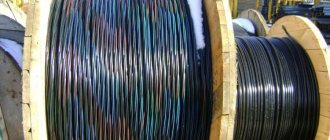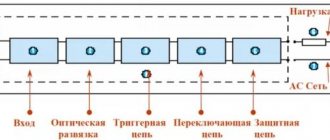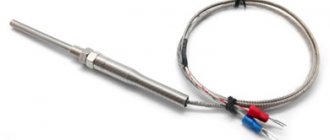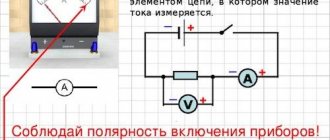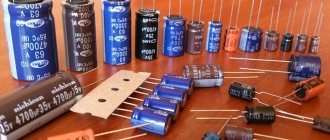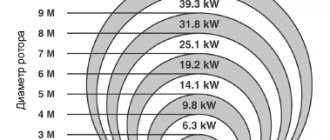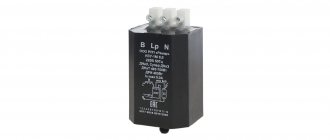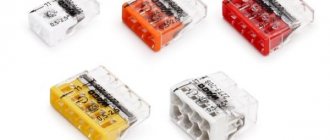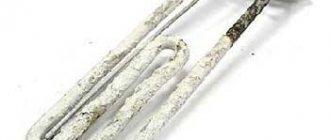Basic rules for using Vago
1. For lighting and other circuits limited in current to 10A, the terminals are excellent; you don’t need to know any subtleties. Connected - and let's go!
2. If the current is from 10 to 20 A, you need to think about the cleanliness of the surface of the wires. Moreover, the current must really be limited by the corresponding circuit breaker (10, 13, 16, 20 A), and the wire must have a cross-section of 1.5 or 2.5 mm². Otherwise it might look something like this:
The Vago 773 terminal block with the paste burned out because... the old aluminum wire was not stripped
3. At currents of 25 A or more, I would limit the use of Vago by moving on to crimping, welding or soldering wires. Although, for quick repairs of home electrical wiring, there are no better or more convenient methods than Vago.
Main types of Vago
The clamps of this company are divided into three most popular categories, the main difference between them is the type of spring:
- Flat spring.
- Cage Clamp.
- Fit-Clamp.
Flat Spring Connectors
Convenient for quick installation of a cable line. Reuse of such clamps is not practiced. It is recommended to use for fastening rigid single-core conductors with a cross-sectional area from 0.5 to 4 square millimeters. Use with flexible stranded conductors is allowed, but in this case the wire tips are pressed together.
Such terminals are good in cases where it is necessary to minimize the voltage drop in long conductors, when installing power lines, to distribute the potential of a six-millimeter wire.
Available in two types:
- For copper wires - clamps without filler (paste). Allows you to connect only copper wires with a cross-section of up to 2.5 mm². Terminal blocks for 2–8 cables.
- Universal - connections that allow the use of aluminum and copper wires. In addition, a copper/aluminium connection is permitted. A special contact paste inside the clamp protects exposed conductors from oxygen and water, minimizing the likelihood of oxidation.
Cage Clamp
Most often used to connect lighting fixtures, inductive motion sensors, electric motors, electric machines, meters, pumps, potentials, heated floors, heating devices, blowers, and distribution boxes. You can use stranded wire without ferrules.
Suitable for stranded and single-core electrical wires with a cross-sectional area from 0.08 to 35 square millimeters. You can combine sections of different areas. Cage Clamps are easy to install and have a long service life. These connectors are considered more expensive.
Fit Clamp
Clamps with mortise contact, the electrician does not need to strip the cable insulation before installation. This technology makes connecting wires even easier. Thanks to Fit-clamp, the speed and quality of connection work increases significantly.
VAG connector series
There are a number of Wago connector series. The most popular of them: 224, 243, 273, 773, 2273, 222, 221. Let's look at the most popular of them:
- 773 - clamps for one-time connection, preferably using single-core electrical wires. Available with or without petroleum jelly filling.
- 222 - connectors with a closing mechanism. Supplied without paste. You can combine single-core and multi-core conductors. Withstand voltage up to 380 V, cross-section up to 4 square millimeters.
How to use Wago 773 terminals at high currents
If I need reliable operation of the Vago 773 connecting terminals at maximum currents (up to 25A), I recommend using the method - strip the wires by 20-30 mm, connect them using the connecting terminal as usual, and twist and insulate the remaining bare parts.
Strengthening Wago 773. Insert the wires
Strengthening Wago. Now we twist it. You can rest assured about contact.
We isolate and quietly seal the contact, its reliability has increased many times over.
Attention! All connection points must be accessible!
How to use Vago 222 terminals correctly
The main thing is to understand that one terminal block is one electrical contact.
How to properly connect Vago 222 clamps
How to properly connect Vago_larger clamps
Now let’s move on from general cases to an analysis of the practical application of these wonderful terminal blocks.
Example 1. How to use Wago 222 terminal blocks
The example shows how easy it is to put things in order in a control panel with automatic machines, where it is a mess, very crowded, there are different wires, and you need to connect more. There is no photo of what was originally, but it may be good. I will consider both the pros and cons.
In the utility room, where everything is made with corrugation, you need to install and connect an additional plastic panel with 4 circuit breakers. Moreover, it must be connected to the existing panel, minimally interfering with it.
It’s correct to say “plastic modular housing”, but I say “shield”, it’s simpler and clearer.
Here is the old panel to which you will connect.
Old electrical panel assembled
What is the main problem with such shields (pictured)? Despite the fact that it is positioned as a housing for 4 circuit breakers (4 modules), 4 circuit breakers fit into it with great difficulty. After all, you still need to connect zeros and grounds. And these are two more terminal blocks. Therefore, you should always leave approximately 20-30% of free space in the shield as a reserve.
The wires of zeros and grounds were connected to plastic terminal blocks with a screw (Lego type), without lugs. And where should I go with my rigid single-core VVG 3x2.5?
Fortunately, German engineers came up with universal clamps Wago 222 , which helped me out. This is how I installed the connections.
An old shield with the cover removed. The wires are connected through Vago clamps
Participating in the connection: multi-core PVA wires with a cross-section of 2.5 (input from the top) and 1.5 mm and single-core VVG 2.5 mm (this goes to my panel, bottom left). If there is another way to connect in this situation, write in the comments.
My shield is installed below, and the connections in it now look like this:
New electrical panel with connections via Wago clamps
Please note, this is important - I chose a panel with 6 modules to install 4 machine modules. There are 3 reasons for this:
- Space for laying wires, you can leave a small margin;
- There is somewhere to place the clamps (terminals), you can put the terminals on a DIN rail;
- For the future, if you need to connect another consumer (not two!), there will be somewhere to install an additional machine.
Close the shield.
New shield assembled. Room sockets, utility room sockets, lighting, boiler.
This is what both shields look like. All the work on installing the panel, automatic devices, connecting wires, laying 4 cables in three corrugations took no more than an hour.
Result - both shields are assembled
The main thing is that the current is limited by the machine to 25 A, the wires are all copper and new, heating will be minimal.
The disadvantage of using Wago 222 connecting terminals this way is that if there is a possible overcurrent, the terminals may begin to melt. Therefore, for peace of mind, it is better to reduce the ratings of circuit breakers.
Methods for fixing conductors
There are 8 ways to fix conductors in terminal blocks, but most often three types are used for domestic purposes:
The clamps on the terminal blocks are spring and screw
Each fixation method has its pros and cons. If you follow the installation rules, they all provide good contact. It’s just that the time it takes to connect the wires varies.
Screw
One of the most popular types of fixing conductors in terminal blocks is with screws. On the market or in stores you can see two types of terminal blocks with screw terminals. The first type is more modern - with closed contact pads. They are hidden in the housing, just like the screw. In the picture below, this option is made of white plastic and is located at the bottom.
Terminal blocks with screw clamping of wires
The wire is stripped to 8-10 mm, inserted into the socket, and tightened with a screw. In this case, neither the bare conductor nor the screw, which is also under the influence of electric current, are accessible to accidental contact. It is perfectly. But in this model there is only one contact plate - at the bottom. Contact is ensured by the screw pressing the conductor against the plate. This is not bad, but only over time the screw pinches the wire, and it may even break off. And if you don’t break off, the contact will worsen.
This type of contact is sealed in the housing
Other screw terminal blocks have open pads (see photo below). From an electrical safety point of view, this is not very good - you can touch live wires. But the clamping screws are equipped with square washers. With this method, the contact has a large area and the wire is not squeezed. To increase safety, similar screw terminal blocks with protective plastic covers are produced. The lids are made of transparent plastic and can be snapped on, hinged, or screwed on with small screws.
A white metal plate is located at the bottom and connects the connected wires, screws with square washers ensure high-quality contact
If you decide to use screw terminal blocks, remember that when connecting copper wires, the screws must be tightened twice. Copper is a soft metal. Once you tighten the screw, the contact is good. To check, they usually pull the wire with force several times. If it's tightened well, it won't move. But after some time, 30-40 minutes, the copper will be crushed under the pressure of the screw. Sometimes so much so that when twitching, the conductor can be pulled out. So you need to re-tighten the clamp.
Spring (spring loaded)
Screw terminal blocks are good for everyone, except that it takes a lot of time to connect the wires. Connecting the four wires is no problem - it only takes a minute or so. And if you need to make a couple of dozen connections... What if there are a hundred?
Spring terminal blocks Vago
Second point: the quality of contact depends on how carefully the screw is tightened. On the one hand, you cannot pinch it, as it may crush the wire. On the other hand, insufficient clamping means poor contact. So there is a “human” factor here, which is not good.
Example 2: Using Wago terminals to repair electrical wiring
The following example shows how to quickly repair electrical wiring that has been broken with a literal axe. The man tried to twist something himself, set up a short circuit in the house, and then called me:
Quick repair of wiring to an outlet. This is what we have today (C)
Here's how I carried out a quick electrical wiring repair using Wago 773 connecting terminals:
Quick repair of wiring to an outlet using Vago disposable terminals
The phase is wrapped with black electrical tape. Then you need to turn off the electricity, carefully hollow out a place for new connections, and plaster over the whole mess. It is better to insulate the places where the wires enter the terminals with electrical tape before doing this.
How to install a socket in such socket boxes is described in detail in my articles about how to reliably install a socket here and here. Be sure to read!
Fast. Just. Reliable. Construction and installation terminals WAGO
The main idea of WAGO terminals is to connect wires using spring clamps. This innovation eliminates the main disadvantage of the traditional screw clamp - loosening over time, which leads to poor contact at the connection and the possibility of a short circuit.
The clamping spring used in WAGO terminals is made of austenitic, chromium-nickel steel with a large tensile strength. The spring in the terminal automatically provides the necessary force for clamping conductors of different diameters.
The body is made of polyamide grade 6.6. It contains no harmful substances: halogens, silicone, asbestos, cadmium, formaldehyde, fluorine dioxide and chlorine dioxide. The material is not subject to corrosion, is resistant to most oils and fats, fuels, as well as to treatment with cleaning agents: alcohol, freon and carbon tetrachloride. It is characterized by low flammability and self-extinguishing properties with a total heat resistance of 105°C. Withstands short-term heating up to 200°C. WAGO terminals can also be used in an already assembled product at very low temperatures up to (-60°C.) Resistance to acids depends on the type of acid and its concentration.
Main advantages of WAGO spring connectors
- reliability of the connection, including a high level of vibration resistance;
- quick and easy installation - work without special tools;
- safety - all live parts are securely closed.
Construction and installation terminals
- Construction and installation terminals for distribution boxes. (episode 773)
- Miniature terminals for distribution boxes. (episode 243)
- Construction and installation terminals for lamps. (episode 224)
- Four-wire terminal for connecting devices and devices. (episode 862)
- Universal Terminal Connectors (222 Series)
Construction and installation terminals for distribution boxes. (Episode 773)
With their help, you can reliably connect single-core/stranded (with rigid cores) copper or single-core aluminum conductors in any combination without the use of tools. They provide reliable and compact wiring of conductors in junction boxes. These are terminals based on a flat spring clamp.
Designed for fastening single-core copper and aluminum (with contact paste) conductors with a cross-section from 0.5 to 4 mm2. Mainly used in terminals for building installations.
Characteristics of 773-3ХX series terminals
Connected conductor cross-section
– copper 0.75 ÷ 2.5 mm2 – single-core 1.5 ÷ 2.5 mm2 – stranded (with rigid cores) – aluminum 2.5 mm2 – single-core • Rated voltage: 400 V • Rated current: 24 A – for copper conductors; 16 A – for aluminum conductors; It is possible to mount these terminals on a DIN rail using mounting adapter 773-332.
Checking for voltage (through technological holes)
Disconnecting a wire already inserted into the terminal (if necessary)
Pull out the conductor by rotating the cable and terminal in opposite directions.
Connecting aluminum conductors
When connecting aluminum conductors, gray opaque terminals filled with special contact paste are used. This paste automatically removes the oxide film from the aluminum conductor and protects it from re-oxidation. Aluminum conductors with signs of severe oxidation are recommended to be pre-cleaned mechanically. All terminals have special test holes. The use of these terminals is a guarantee of safety and order. Each conductor has a separate terminal point, which eliminates the possibility of a short circuit or heating at the point of contact.
Miniature terminals for distribution boxes. (Episode 243)
These terminals are well suited for mounting thin wires used in low-current applications (telephony, security alarm systems, indoor access control, telecommunications, etc.). They can be assembled into assemblies, installed in adapters and on printed circuit boards
All the advantages of WAGO mini terminal blocks with flat spring clamp for distribution boxes are retained when the terminals are mounted on a 35 mm DIN rail. For this purpose, special mounting brackets are used. It is also possible to combine the terminals into terminal blocks.
The brackets are designed for 4 or 6 terminals, which simply slide into the grooves of the bracket, and can be easily removed if necessary.
The bracket is directly attached to the DIN rail, or screwed to the mounting surface. A large marking surface on which you can make marks with a marker makes your work much easier. The rules for working with them are the same as with conventional box terminals.
Construction and installation terminal blocks for lamps. (Episode 224)
Terminals for lamps are ideally suited for connecting: • chandeliers, sconces, lamps. • electric motors for blinds, roulades and awnings, • fans for windows and bathrooms, • control units for heating boilers, • stationary terminals for connecting electrical appliances using flexible network cables, • circulation pumps, • etc. without the help of tools. They are completely insulated and therefore reliably protect against contact with live parts of conductors.
A distinctive feature of these terminals is that they have two types of clamps: on the mounting side it is the already familiar flat-spring clamp for single-core conductors, and on the connection side it is a CAGE CLAMP® clamp for connecting multi-core, including tinned or pressed, copper conductors from a lighting fixture.
CAGE CLAMP
Designed for fastening any types of conductors with a cross-section from 0.08 to 35 mm2. Used in most DIN rail, PCB and plug-in terminal connectors.
Rules for using WAGO construction and installation terminals for lamps
1. Remove the insulation from the conductors by 9-11mm. There are measurements on the terminal for proper stripping of the insulation. The cleaned area on the mounting side should not have strong bends.
2. Insert the stripped hard conductor from the mounting side (from the wall, ceiling) into the round hole until it stops.
3. Squeeze the terminal from the side of the rectangular hole (from the side of the lamp) until it stops and guide the stripped conductor into it.
4. Use the slot-shaped hole on the back side of the terminal body to check the electrical parameters of the network.
5. If necessary, disconnect the lamp, squeeze the terminal from the side of the rectangular hole and remove the conductor from the terminal.
6. If necessary, disconnect the terminal, pull the conductor out of the terminal, twisting it from side to side.
Before connecting aluminum conductors, it is necessary to fill the terminal with special contact paste on the mounting side.
Four-wire terminal for connecting devices and devices. (Episode 862)
This terminal is designed for connecting single-core and stranded copper conductors. The terminal body is made of polyamide 6.6 VO, the operating temperature range of which is from - 60 to +105oC The use of such a terminal minimizes the costs associated with connecting new devices. Up to four conductors with a cross section of 0.5-4.0 mm2 can be connected to one terminal. simultaneously. Moreover, both single-core and multi-core conductors and different sections. This is possible due to the fact that the terminal uses a CAGE CLAMP S.
The CAGE CLAMP S allows you to connect up to 4 single-core and stranded conductors with a crimp sleeve (or core seal) with a cross-section from 0.5 mm2 to 4 mm2 into one terminal without using a tool (by simply pushing it all the way).
In addition, it is possible to select terminals with a grounding pin, which will ensure direct contact with the circuit board even if it is covered with a protective varnish film. The fact is that the mounting foot automatically removes this film at the PE contact. Fig.24
The terminal tab is large enough to press with a finger or a screwdriver. .Pole markings are factory laser engraved, which eliminates the possibility of accidental erasure. You can place a label with any desired inscription, printed on a printer, in the center of the terminal. To check the terminal, use a special probe with a diameter of 2 mm2
Installation of terminals in this series is very simple. You can simply fix the terminals to the surface using special fixing legs, or you can use M3 screws or D 2.9mm self-tapping screws.
Universal Terminal Connectors (222 Series)
These terminals are one of the latest developments by WAGO, but they are already popular with consumers. They produce two-, three- and five-wire terminals. You can connect conductors with a diameter from 0.08 to 4 mm2 (single-core and stranded up to 2.5, fine-wire up to 4). Series 222 terminals are very easy to use, compact, and reliable. They use a spring connection of the CAGE CLAMP Сompact type, which ensures reliable connection of both single-core and stranded copper conductors with a wide range of cross-sections
CAGE CLAMP® Compact Used to connect all types of conductors from a minimum of 0.08 sq.mm to 4.0 sq.mm. The CAGE CLAMP® Compact saves significant space compared to the traditional CAGE CLAMP®. This makes it possible to create terminals with smaller physical dimensions. As with the CAGE CLAMP®, the new clamp consists of the same two parts: a nickel-chromium spring steel spring and a special tin-plated electrolytic copper current bar.
The 222 Series Terminal connects conductors to connect lights, blinds, shutters, door operators, intercoms, pumps, speakers and more.
Technical characteristics: 0.08 – 2.5 mm2 single+multiple; 4 mm2 fine wire; (400V 32A) AWG 28 – 12 (600V 20A)
Rules for using universal terminal connectors 222 series 1. Remove the insulation by 9-10 mm. 2. Open the input hole of the terminal by lifting the lever all the way and insert the conductor. 3. Lower the lever to its original position.
Thanks to the recessed lever, it is impossible to accidentally press it incorrectly when inserting it into a tight installation space.
Examples of using:
Connecting flexible conductors in a junction box.
Loop connection of a lighting device with flexible conductors.
Connection of pre-assembled components.
Connecting low-voltage lamps.
Buy WAGO terminals on the website
Example 3. Repair of distribution unit
In this (I don’t dare call it a box) ... This box of wires has everything - the input from the entrance (wires thinner than one and a half rubles, turning into aluminum, turning into a ball-and-socket screw with single-layer insulation, and rigid wires, and flexible wires, and copper, and luminium.
How did it work? Don't know. The owner called me when he himself caused a short circuit, and the floor of the apartment was left without voltage. At the same time, the entrance Soviet machine gun 25A did not work, which is natural.
I temporarily restored the power (the wires were burned out) by using two Vagos (222 and 773, can be seen at the top of the photo):
Repair of old aluminum electrical wiring. The worst thing is that people lived with this for many years, it was simply covered with plaster, and the machine was set to 25A!
A couple of days later I came again, first threw out everything unnecessary, and figured out what came from where and where. I also threw out the wires from the entrance, I will lay new ones later:
Repair of old aluminum electrical wiring. On the left there are wires - light for the toilet and power supply for the entire apartment. Down – toilet and bathroom switch. On the right is the bathroom light and kitchen power.
Now, using pieces of hard copper wire and Vago terminal blocks for different numbers and different types of wires, I assemble a circuit:
Repair of old aluminum electrical wiring. The VVG3x2.5 cable from the entrance comes from below. Wago 222, Wago 773 with and without paste were used.
Here's what we ended up with:
Repair of old aluminum electrical wiring. Vago helps out great!
Of course, if you do everything wisely, you need to completely change the wiring in the entire apartment. But such a task was not before me.
I am calm about my work and this apartment, especially considering that it is now powered through a 16A circuit breaker. And the most powerful consumers are the washing machine and refrigerator.
Types of WAGO terminals
On terminal block markings, the first three digits indicate their series. It may seem that this makes no sense, because they are visually different. However, they also differ in the technical characteristics indicated by the markings. This is important, because if the contact is not reliable enough, this can lead to wiring failure, even a fire.
The following types of clamps are available:
- PUSH WIRE - flat spring clamp.
- CAGE CLAMP - reusable terminal blocks.
- FIT-CLAMP - self-clamping terminals.
In the first type, PUSH WIRE, the spring performs two main tasks:
- holds the wire, thereby pressing it to the bus;
- Protects against cables being disconnected from each other due to its location.
Their spring is at an angle to the cable, so connecting it is much easier than disconnecting it. When this happens and they try to remove it, the spring will crash into it with its end. The contact group also has a special feature. It is not designed for frequent removal, so the cable and spring may be damaged.
Also touching on the spring, it is worth noting that it provides very little resistance, but it is enough to make it difficult to connect a stranded wire. And if it has a high class of flexibility, then it is impossible to connect it without using a special rigid tip.
CAGE CLAMPs, on the other hand, were designed to be used multiple times. Its spring is flat, curved, with a rectangular socket for the cable in one part, for the current-carrying busbar on the other. The busbar and wire are connected to each other due to elastic force.
If you press on the spring from above, the window opens slightly, which allows you to remove the cable without effort. In this case, any flexibility class is suitable.
FIT-CLAMP has been produced not so long ago and is based on a mortise contact. To work with this terminal, you do not need to strip the conductors, which greatly simplifies the work process.
The following wires are suitable for connecting wago terminal blocks:
- Single-wire copper and aluminum.
- Stranded copper.
- Multi-wire tinned.
- Stranded with different types of tips (sleeve or pin).
Of course, each of the types presented above requires its own type of terminal. However, it will be difficult not to find a suitable one, because in addition to the types, these devices have different series.
Example 4. Wago terminal blocks: how to use when installing a new junction box
I’ll give you an example of how I make connections in a distribution box when installing new electrical wiring.
Here's a cheap option. This is the hallway. Through a 20A machine, a cable with wires with a cross-section of 2.5 mm² comes into the box, and diverges into 1 socket (2.5 mm²), lighting and a bell (1.5 mm²).
Initially, after the plasterers, we have this:
Connecting wires in a new junction box. Let's sign the wires. On the left, a VVG2x1.5 cable for the bell sticks out of the wall. Guess through which terminals I will connect it)?
We strip the wires and determine where we have what. As usual - white phase, blue zero, yellow-green - ground. For switches - white phase, blue first key, yellow-green - second.
Connecting wires in a new junction box. wires are stripped, targets are identified
Connecting wires in a new junction box. The stripped wires are ready for connection.
3-5 minutes - and you're done:
Connecting wires in a new junction box via Vago 773
Close the box with a lid
Now you can plaster and paint or wallpaper. It is important that there must be access to the box, or at least its location must be known. Who knows what could happen in 20-30 years?
Don't forget to check everything!
Another example of using Wago 773
Below is a photo showing the use of Wago terminal blocks when disconnecting wires in a junction box.
Application of Vago terminal blocks. Another example
What can you say about this photo?
1. The wire used has a cross-section of 1.5mm2. This means that the circuit breaker through which this box is powered must have a current of 13A, or better yet, 10A.
Wago 773-302 terminal block with paste is adapted for connecting the lamp , which actually holds more current than the orange terminal blocks 773-324 , through which power goes to the sockets. It's better the other way around, if possible.
3. It is better to separate power outlet lines and lighting lines, since currents of different magnitudes flow in them (the difference is an order of magnitude). And accordingly, different circuit breakers for different currents. Another advantage of this connection is that if the machine breaks due to an overload or a short circuit in the socket, the light in the room will remain on.
Characteristics of Wago
Vago terminal blocks are used both in household electrical wiring and in industrial devices. This explains the wide range of their technical characteristics.
The conductive part of the connector is made of copper. This material conducts electricity well without significant heat losses. The copper is coated with a thin layer of soft tin-lead solder. Its task is to maximize electrical contact with the wiring.
Dimensions of terminal blocks of the car
The terminal block insulation is made of overheat-resistant material. It can withstand temperatures up to 200 °C for a short time. This property is necessary from the point of view of fire safety requirements.
Application of stranded wires
As I already said in the articles, stranded flexible wires are connected through Wago 222 terminals with a lever. However, flexible wires can also be connected through disposable 773. To do this, you need to use tips:
Flexible wire with lugs. The two tips on the right are not crimped
The tips are crimped using a special tool; pliers are not enough:
Tips for wires. Crimping in action
After this, you can use flexible wires on the same basis as rigid wires using one type of Wago clamp. For example, like in this photo:
Flexible wire into disposable Wago 773 through lugs
Another bonus is the tool and tips.
Crimping pliers, popularly known as crimping tips
Who doesn’t like IEK, you can use the branded one from Wago
Tips are sold in different sizes
They have different colors for convenience. May vary from manufacturer to manufacturer.
And they can be stored in this case
How to use Vago terminal blocks correctly
The main rule of working with terminal blocks from WAGO is to use one terminal for one contact. First of all, the wires are cleaned from 1-1.2 cm of insulation. After this, they are inserted into the connector until it stops. If the connector has a clamp with a lever, it must first be opened before insertion. When the wire is inserted, the lever is lowered down with force and the terminal strip is pressed.
It is important to ensure that exposed wire sections do not extend beyond the device. Otherwise, contact will be compromised, as will the security of the connection.
Important! If something goes wrong, you should not use the clamp a second time, even if it looks normal and functional. The same applies to their replacement, which is done from time to time.
Pliers for some terminal blocks
Thus, screw terminal blocks for connecting wires from WAGO are one of the best solutions in the clamping market. They are many times safer than twisting, and rarely require any additional tools for work, except for certain types, when terminal pliers may be needed.
You may be interested in this Connecting conductors
